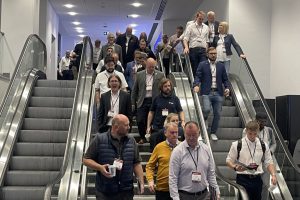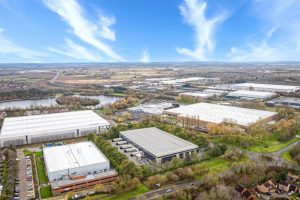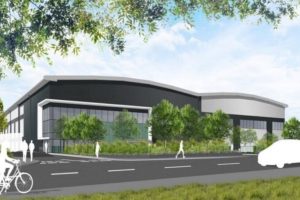Make forklift safety your priority
Here we present key takeaways from experts on forklift safety covering subjects such as dealing with awkward loads, pedestrian awareness of forklifts, training agency workers and much more. The Round Table took place in November 2019.
Forklifts are a vital tool in the running of UK logistics. Just as vital, managers responsible for forklifts must be aware of safety and striving continually to improve operations. The consequences of not doing so can be dire indeed. In fact, even non-fatal incidents involving forklift trucks frequently result in life-changing injuries. That’s why we brought together some key industry experts to see what we could learn. The aim here is to give guidance to help managers better cope with the ever present dangers and challenges that arise from using forklifts.
Some of the challenges arise from specific applications. For example, the use of VNA (very narrow aisle) configurations has given a huge boost to space optimisation for warehouses. But in 2016 a 3PL saw a forklift collision in VNA aisles which led to the death of an operator. We step in to the discussion to see what can done to counter this risk.
Alexander Glasmacher, managing director, Elokon: “By law, to operate a VNA warehouse in Germany you have to have either mobile or stationary protection that prevents a truck and a pedestrian, or two trucks, being in an aisle at the same time.
“On the stationary side, we can install infrared gates that indicate whether there is already a pedestrian or a truck in the aisle. For mobile, or on-truck technology, you can have electronics with laser scanners that scan the front and the rear of the truck and can detect pedestrians and other vehicles and automatically slow the trucks down. This is the primary technology that is being used in VNA applications to prevent this type of fatal accidents.”
A trend we have seen in recent years is for some applications, such as manufacturing and DIY stores, to switch from ride-on forklifts to pedestrian trucks. Are safety concerns driving this?
Martin McVicar, co-founder and CEO of Combilift: “Yes, Cummins is a great example as a manufacturer. This is a trend we feel will continue to grow. An operator of a pedestrian forklift has 360 degree vision of what they're doing. They are more nimble and because they are on the ground, they're more cautious in terms of their operation. You're not going to reverse the forklift and hit it off a rack, for example.”

Sam Gray, sales training & product development manager at Toyota Material Handling UK: “Handling applications are diverse. We are seeing more forkless applications with counterbalance trucks replaced with pedestrian or towing solutions. For example, we recently implemented our T-mote solution in a semi-automated order picking application with one of our major car customers. It is faster and operators are not required to jump on and off the trucks to pick items so it reduces fatigue and risk of slips.”
Stuart Taylor, managing director, Mentor Training: “It is absolutely true about the 360 degree vision of pedestrian truck operators. One point to make sure of though, is that using pedestrian trucks is not a way of encouraging interaction between pedestrians and pedestrian trucks, because they carry a heavy load and can still cause injury. If you look at the breakdown in statistics, pedestrian trucks actually cause more injuries than ride-on trucks. The injuries are not as headline grabbing but lower limb injuries can still be life changing. No piece of equipment can take the place of a good, safe system of work and the education staff.”
Another application, and one that people maybe wouldn’t think of first in terms of safety, is eCommerce. As retailers ramp up for Peak in particular, careful consideration must be given to how forklifts are operating in much busier times, with perhaps many new staff recently taken on board.
Stuart: “Statistically new workers are two to three times more likely to have an accident in the first six months of their employment. Consideration should be made for them. Also, the law makes it absolutely clear that exactly the same controls should be applied to agency workers as full time employees. We often see situations where the credentials of agency workers are not checked.
Martin: “Where possible, use full-time employees on forklifts and have agency workers take on other tasks.”
Stuart: “Familiarisation training is often ignored and is something you could do in-house with a competent person. It's about making sure new starters understand your layout, your system, your emergency processes, if you have any gradients, for instance, and also your load types as well.
Sam: “With Toyota I_Site, you can set agency staff different parameters to settled staff. You might want to limit speeds, for example, until workers are more comfortable in the new environment.”
Stuart: “The irony for me is that agency workers are generally brought in at peak times when you're at your busiest, where you don't want to have issues and accidents and disruptive damage because it affects your productivity. So, a little bit of upfront investment in familiarisation training can have real financial benefit as well as reduce the risk of accidents.
“Invest a little bit of time in checking their qualifications, assess their skills and their understanding of your business. There may be a requirement for additional supervision, especially if agency workers don't have English as a first language.”
Alex: “I would suggest have a dedicated safety employee to take care of the agency workers and to provide special supervision.”
The exceptions are something to look for in your business. Whether it is new employees, busy times of the year, or unusual or unconventional loads. One recent example of the latter is an incident where two forklifts dropped a load of rebar injuring a banksman. What can be done to tackle this kind of challenge?
Martin: “Two forklifts lifting a load is not good practice in any business environment. And rebar is a long product – Combilift has multi-directional vehicles that can lift long product and travel laterally. That would be the best solution for that scenario. It's a non-runner to have two forklifts lifting any kind of load.
{EMBED(1141682)}
“There was one example of a company using four forklifts to lift a lorry load of structural steel, which has all kinds of problems.
“Another related point is to avoid operators on the top of truck bodies, putting straps on for example, when large, unusual loads are being moved. That’s still common practice. We've developed the straddle carrier so you can lift a lorry load with one vehicle safely.”
Sam: “It doesn't hurt anybody to stop and do a quick risk assessment if an unusual or difficult load needs to be moved. Ask ‘is it the right thing to do and have you the right piece of equipment?’ Perhaps there is a risk assessment for 95% of the work that's being done. But every now and again, an unconventional load might come in and perhaps the employees don't know how to handle it. Staff should be comfortable enough to say, ‘okay, we've not handled this type of load before, so let's take five minutes and think about this.”

Martin: “Forklifts are rated for certain capacities and one of the leading contributors to accidents is if an operator is trying to lift two pallets together. We've noticed some of our clients putting decals such as ‘One lift, one load’ on the product, it’s basic but effective.”
Stuart: “If a forklift operators has accredited training, they know how to assess and handle a load. They also know what to do if there is an unfamiliar load. But you can't just put this on the forklift operator. The big question for me is, why was there a person in proximity to the truck? Accidents generally result from a combination of errors. If the load had fallen but the individual was not in the vicinity we wouldn't be having this discussion now because, worst case scenario, the load would have been dropped.
“Recognise the importance of keeping people away from forklift trucks that are loading and unloading. We've seen three major accidents over the last year where drivers have been injured and often on curtainsiders carrying out multi-drops where the driver will hold the curtain to allow the forklift operator to take the load off, and if there's an issue with the load the natural reaction is to try and help them, which can go very badly for the driver.”
As we have so far seen, in many of the answers, it is people that are most often the issue. Whether it is a tired or complacent operator, or a new starter who is insufficiently aware of the dangers, or untrained in how to deal with them, you must win your people over to the cause of safety.
Stuart: “Culture is a word we hear a lot but a good safety culture is one of the hardest things to achieve. Listening to the HSE’s Kanwal Kanda he's particularly frustrated because you can't create a culture from the bottom up. It's got to come from senior management. The executives have got to buy into it. Quite often we'll see middle line managers with initiatives and it cascades down to the shop floor. But that is hard to sustain, and safety must be a continual process.”
Sam: “You have to look closely at culture. In some operations employees earn bonuses based on pick rates, and you need to make sure health and safety does not go by the wayside in these circumstances. One of Toyota’s core values is go to the source (Genchi Genbutsu), you can't fix anything sitting in an office. If the problem is down in the warehouse, go down into the warehouse and have a look for yourself to see what the problem is.”
Martin: “Manufacturers and customers expect a lot from our forklift operators. We're expecting a forklift operator to sit on a piece of equipment, look at a load capacity chart and understand what they are lifting on a pallet. We all know the weight and load centre may vary. They are doing a lot mentally, so experience is important. We need to be adding tools to the equipment to make it easier for operators to do their task. The approach we’ve taken, and it's been used in the construction industry for many years, is including load monitors to make it easier for the forklift operator to know what they're lifting.”
Alex: “We hear more and more from our customers that forklift operators are overloaded with gadgets, so we are deeply involved in discussions with other companies on how to improve the man-to-machine interface to avoid distraction use electronics instead to seamlessly help them safely drive their vehicles.”
Stuart: “Management supervision plays a key part for various reasons. They have to be responsible for continually overseeing an operation. Forklifts are operated by people and people can become complacent. They don't work at their absolute best every single minute of every single day. So you do need trained management and supervision to oversee that. We do think in the UK at the moment that's one of the key factors that's missing, which is why maybe our injury stats have remained pretty static over the last four or five years.
“Sometimes, there may be a reluctance to discuss and communicate because they may not understand the risks, terminology and components of a lift truck. That's the technical element, but also, do they engage and communicate in a non-confrontational and positive way that actually gets good results?”
Sam: “We need to make sure people can talk without fear of retribution and have a reporting system that is fair and works. If you've got middle and upper management that people are afraid of, then it's quite difficult to say ‘excuse me, I think you've got that wrong’.”
Martin: “In the last five years, forklift operators and pedestrians have become more vocal about safety. Most business will have records of near misses, but what we've introduced in our business is the term ‘good catch’. Looking at it more positively helps emphasise that it’s everyone’s job to help develop that culture of safety.”
Stuart: “Do people recognise bad practice? A manager may not have driven a truck before, so can they spot sloppy practice? When operators do the same tasks thousands of times without any negative consequences, the risk fades in their mind and that's part of biology and the way we're created.”
A key issue is the segregation of forklifts and pedestrians where possible. Think hard about whether or not you need pedestrians in the same zones as forklifts at all. If it can’t be avoided, make sure both operators and pedestrians are forklift safety aware.
Stuart: “The stats show about 57% of injuries are to pedestrians. The sites we visit show a mixed picture. Some have excellent physical segregation, whereas for others that’s not practicable. So they'll have other systems in place. The key thing is to have a policy in place and follow it, because we are hardwired to take shortcuts. There's a lot of talk now about putting walkways that follow how people would naturally walk, where possible.

“There is a strong argument for training everybody in your business about the dangers of forklift trucks, including people who don't often visit the site, or office workers that seldom visit the warehouse. These people can be particularly vulnerable to dangers. But again, putting barriers in is not a fix on its own.”
Sam: “We spend a lot of time and money training our forklift operators to use equipment as safely as possible. How much time and effort do we spend on the pedestrians? The starting point has to be complete segregation. Can we achieve that and still be productive? If that isn’t possible, find the right balance for your company.”
Martin: “Just take the eCommerce business, as SKUs are increasing on a monthly basis, there's got to always be interaction between pedestrians and forklifts. It's going be very hard to eliminate completely.”
Sentencing guidelines have meant significantly higher fines for companies found guilty of serious breaches of health and safety law. This has had some impact in raising awareness of the need for strong forklift safety, but there is some debate on how much impact it has had.
Stuart: “Companies are more aware, but sometimes companies say ‘it happened to someone else, it’ll never happen to me’. I often think personal stories are more powerful than financial motives. The FLTA safety ambassador Lisa Ramos is someone who had a life changing injury from a forklift and people relate to the effect that had on her and her family. Often these stories don’t even make the news. Someone is run over by forklift. What does that mean? They could have a leg amputated, their life is changed.”
A positive and effective safety culture can have far-reaching benefits to the business. It isn’t just about getting incident numbers down and protecting employees. Companies can save a lot of money by reducing damage and lost-time incidents.
Sam: “You need to think about the on-costs as well. If you do lose a pallet, there is the cost to clear the aisle, lost-time costs when the aisle is out of use, etc. About 70% of the cost of a forklift operation comes down to the operator. Investment in a safety culture helps to drive down those costs.”
Martin: “Safety does bring efficiency long term, it's a win-win to focus on safety.”
Technology can help boost forklift and warehouse safety. The future holds out the promise of telematics combined with wearable technology on pedestrians and operators to map and perhaps respond to potential incidents in real time.
Alex: “We are seeing the effects of two megatrends. One is digitisation and the other is autonomous driving. We see new sensor technologies coming out of autonomous driving that we can use in the warehouse. We see a trend towards improving the man to machine interface. The most important thing is falling cost. Today, many of these products are cost prohibitive but with the widespread use of autonomous vehicles, sensors will significantly reduce in price, meaning greater use of sensors.”
Sam: “I_Site telematics are standard on our warehouse equipment. For the future, keeping trucks connected will mean they can be updated and improved continually.”
Alex: “Proximity detection systems enable a fork truck to recognise a pedestrian or a truck pre-emptively. In the future, we don’t want to just cover impact recording but also predictive impact management. We believe that we can prevent 80% of these impacts that are recorded today by fleet management systems from actually happening. So the future is very exciting and there is a lot of opportunity for new products.
“An issue can be over-sensitivity. Proximity detection systems are often able to detect pedestrians in the next aisle and many customers do not want that. That is a very big challenge in engineering these types of products. We’ve also seen a lot of visual alarm systems coming in.
“Telematics are bought to increase safety, for impact management, and to enforce pre-shift electronic operational checks, and we do see a change in behaviour through telematics, which is very positive with respect to safety.”
Stuart: “I would caution that telematics in themselves do not create good culture. The business needs to want these tools for the right reasons. A a recent FLTA conference, Kellogg's highlighted how they put systems in place, yet the operators ‘covered over’ speed control systems. So, the tools must work in tandem with a good safety culture and management, if you really want to get the most out of them.”
Martin: “One trend we've seen in the last 10 years, with the growth of electric forklift trucks, is that pedestrians don't always hear the vehicle. I think audible alarms, in my opinion, are probably not loud enough or they're only in a single direction. But forklifts may be reversing or turning 90 degrees, and so the use of audible alarms needs to develop and increase.”
{EMBED(1141685)}
Looking to the future, handling in the warehouse is likely to involve more robots. This is generally reckoned to be safer, but robots and AGVs do not come without their own risks, especially when used in areas where pedestrians have access.
Alex: “If we look at item picking where pedestrians and mobile robots do or will typically work together, we can install proximity detection systems on mobile robots to be able to work faster in the vicinity of pedestrians.
“The whole area of AGVs, mobile picking robots is very, very exciting and very important and also with respect to safety in the warehouse. We see more and more accidents happening with AGVs or mobile robots.

“I think the solutions that work for forklifts can be ported over to work with robots. We have pilot installations where we install our systems both on forklifts and mobile robots. In many situations, they will work alongside one another.
“We need to be driving towards zero accidents around trucks and technology is a big enabler in making this happen.”
Sam: “There's definitely not a magic wand but I think we're going in the right direction.”
While technology is fast advancing, it is important not to neglect the basics that any operation can quickly implement at low or no cost.
Stuart: “If you are a site at the start of the journey, and there are many, there are low-cost, practical measures you can take, so start there. That could be having real one way systems, having mirrors on corners, or something as simple as putting a barrier in front of the door where you know people come in and out of the warehouse.”
We hope this article, and the associated video of the full round table conversation, is helpful in sparking ideas and debate with your own company and I hope this process leads to better forklift safety across the UK.






